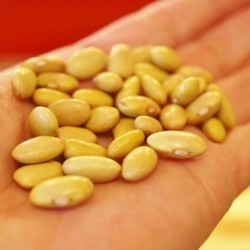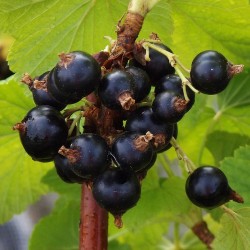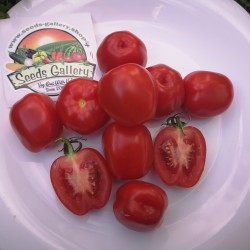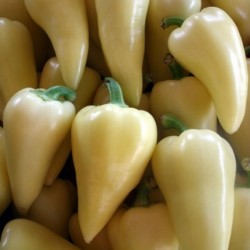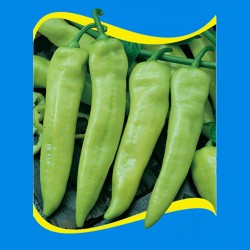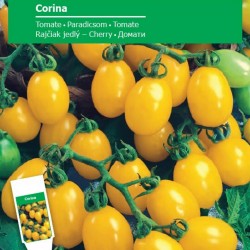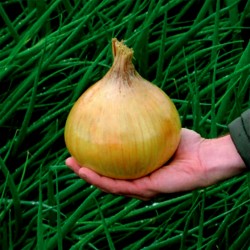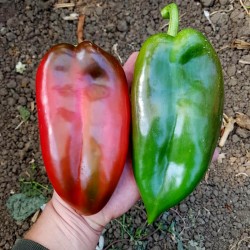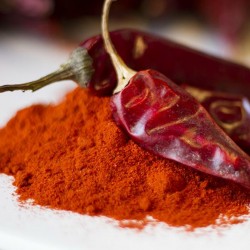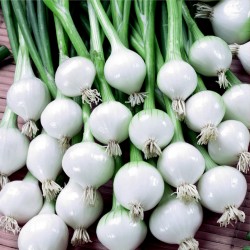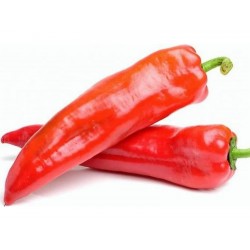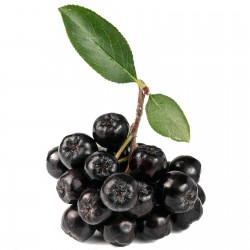
1000 Seeds Chokeberry...
Ціна
11,00 €
SKU: V 29 (4g)
Seeds Gallery Com,
5/
5
<h2><strong>1000 Seeds Chokeberry (Aronia melanocarpa)</strong></h2>
<h2><span style="color: #ff0000;"><strong>Price for Package of 1000 seeds.</strong></span></h2>
<p>Aronia melanocarpa is an extraordinary medicine plant that has been developed in Poland. It has an incredible array of health qualities. Known as Chokeberry, the native Americans used it to prepare pemmican (dried meat). It has a higher concentration of vitamin C than blackcurrants, but it also contains a host of other valuable substances, especially antioxidants, polyphenols, bioflavonoids, and tannins. It is a very hardy and vigorous plant and can survive most conditions.</p>
<h3><strong>Wikipedia</strong>:</h3>
<p><i><b>Aronia</b></i><span> </span>is a genus of<span> </span>deciduous<span> </span>shrubs, the<span> </span><b>chokeberries</b>, in the family<span> </span>Rosaceae<span> </span>native to eastern North America and most commonly found in wet woods and swamps.<span> </span>The genus is usually considered to contain two or three<span> </span>species, one of which is<span> </span>naturalized<span> </span>in Europe.</p>
<p>Chokeberries are cultivated as<span> </span>ornamental plants<span> </span>and as<span> </span>food products. The sour berries, or<span> </span><b>Aronia berries</b>, can be eaten raw off the bush, but are more frequently processed. They can be found in wine, jam, syrup, juice, soft spreads, tea, salsa,<span> </span>chili starters, extracts, beer, ice cream,<span> </span>gummies,<span> </span>and<span> </span>tinctures.<span> </span>The name "chokeberry" comes from the<span> </span>astringency<span> </span>of the fruits, which creates the sensation of making one's mouth pucker.</p>
<p><i>Chokeberries</i><span> </span>are often mistakenly called<span> </span><i>chokecherries</i>, the<span> </span>common name<span> </span>for<span> </span><i>Prunus virginiana</i>. Further adding to the ambiguity, a<span> </span>variety<span> </span>of<span> </span><i>Prunus virginiana</i><span> </span>is<span> </span><i>melanocarpa</i>,<sup id="cite_ref-9" class="reference">[9]</sup><span> </span>and readily confused with<span> </span><i>black chokeberry</i><span> </span>because it is commonly referred to as "black chokeberry" or "aronia". Aronia berries and chokecherries both contain<span> </span>polyphenolic<span> </span>compounds, such as<span> </span>anthocyanins, yet the two plants are distantly related within the family Rosaceae.</p>
<p>The<span> </span>leaves<span> </span>are alternate, simple, and<span> </span>oblanceolate<span> </span>with<span> </span>crenate<span> </span>margins and<span> </span>pinnate<span> </span>venation; in autumn the leaves turn a bold red color. Dark<span> </span>trichomes<span> </span>are present on the upper midrib surface. The<span> </span>flowers<span> </span>are small, with 5<span> </span>petals<span> </span>and 5<span> </span>sepals, and produced in<span> </span>corymbs<span> </span>of 10–25 together.<span> </span>Hypanthium<span> </span>is urn-shaped. The fruit is a small<span> </span>pome, with an<span> </span>astringent<span> </span>flavor.</p>
<p><i>Aronia</i><span> </span>has been thought to be closely related to<span> </span><i>Photinia</i>, and has been included in that genus in some classifications,<sup id="cite_ref-10" class="reference">[10]</sup><span> </span>but botanist Cornelis Kalkman observed that a combined genus should be under the older name<span> </span><i>Aronia</i>.<sup id="cite_ref-Kalkman_11-0" class="reference">[11]</sup><span> </span>The combined genus contains about 65 species.<sup id="cite_ref-weakley_12-0" class="reference">[12]</sup><span> </span>In 2004, Kalkman expressed doubt about the<span> </span>monophyly<span> </span>of the combined group, and new molecular studies confirm this.<sup id="cite_ref-Potter_13-0" class="reference">[13]</sup><sup id="cite_ref-Campbell_14-0" class="reference">[14]</sup><span> </span>They do not place these two genera together or even near one another.</p>
<p>In eastern North America are two well-known species, named after their fruit color, red chokeberry and black chokeberry, plus a purple chokeberry whose origin is a natural hybrid of the two.<sup id="cite_ref-weakley_12-1" class="reference">[12]</sup><span> </span>A fourth species,<span> </span><i>Aronia mitschurinii</i>, that apparently originated in cultivation, is also known as<span> </span><i>Sorbaronia mitschurinii</i>.</p>
<h2><span class="mw-headline" id="Cultivation">Cultivation</span></h2>
<p>Aronia is considered cold hardy and heat tolerant in<span> </span>USDA<span> </span>Zones 3 to 8.<sup id="cite_ref-usda_17-0" class="reference">[17]</sup><sup id="cite_ref-18" class="reference">[18]</sup><span> </span>Aronia plants grow well both in<span> </span>orchard-type rows or set as<span> </span>landscape<span> </span>elements, including several varieties in 3 to 12 foot heights.<sup id="cite_ref-usda_17-1" class="reference">[17]</sup></p>
<h3><span class="mw-headline" id="Products_and_uses">Products and uses</span></h3>
<p>The chokeberries are attractive<span> </span>ornamental plants<span> </span>for gardens. They are naturally understory and woodland edge plants, and grow well when planted under<span> </span>trees. Chokeberries are resistant to drought, insects, pollution, and disease. A number of<span> </span>cultivars, including<span> </span><i>A. arbutifolia</i><span> </span>'Brilliant' and<span> </span><i>A. melanocarpa</i><span> </span>'Autumn magic', have been selected for their striking fall leaf color.</p>
<p>An aronia wine is made in<span> </span>Lithuania. In<span> </span>Poland, aronia berries are added to jams and juices or dried to make a herbal<span> </span>tea<span> </span>sometimes blended with other ingredients, such as<span> </span>blackcurrant.<sup id="cite_ref-mckay_19-0" class="reference">[19]</sup><span> </span>In<span> </span>Bosnia and Herzegovina, the berries are sold fresh and frozen or made into juices, jams and teas.<sup id="cite_ref-Fresh_Fruit_Portal_20-0" class="reference">[20]</sup><span> </span>Aronia is also used as a<span> </span>flavoring<span> </span>or<span> </span>colorant<span> </span>for beverages or yogurts.<sup id="cite_ref-mckay_19-1" class="reference">[19]</sup><span> </span>Juice from the ripe berries is<span> </span>astringent, semi-sweet (moderate sugar content), sour (low<span> </span>pH), and contains a low level of<span> </span>vitamin C.<sup id="cite_ref-21" class="reference">[21]</sup><span> </span>The berries have a tart<span> </span>flavor<span> </span>and, in addition to juice, can be baked into breads.<sup id="cite_ref-mckay_19-2" class="reference">[19]</sup><span> </span>In the United States and Canada, aronia<span> </span>juice concentrate<span> </span>is used in manufactured juice blends.</p>
<h3><span class="mw-headline" id="Polyphenol_content">Polyphenol content</span></h3>
<p><i>Aronia melanocarpa</i><span> </span>(black chokeberry) has attracted scientific interest due to its deep purple, almost black<span> </span>pigmentation<span> </span>that arises from dense contents of<span> </span>polyphenols, especially<span> </span>anthocyanins. Total polyphenol content is 1752 mg per 100 g dry weight,<sup id="cite_ref-Phenol-Explorer_22-0" class="reference">[22]</sup><span> </span>anthocyanin content is 1480 mg per 100 g dry weight, and<span> </span>proanthocyanidin<span> </span>concentration is 664 mg per 100 g fresh weight.<sup id="cite_ref-Wu_23-0" class="reference">[23]</sup><sup id="cite_ref-24" class="reference">[24]</sup><span> </span>These values are among the highest measured in plants to date. The black aronia species contains higher levels of anthocyanins than purple (<i>Aronia prunifolia</i>) or red aronia (<i>Aronia arbutifolia</i>), whereas red and purple aronia are richer in phenolic acid and proanthocyanins.<sup id="cite_ref-pmid23941506_25-0" class="reference">[25]</sup></p>
<p>The plant produces these pigments mainly in the leaves and skin of the berries to protect the pulp and seeds from constant exposure to<span> </span>ultraviolet radiation<span> </span>and production of<span> </span>free radicals.<sup id="cite_ref-simon_26-0" class="reference">[26]</sup><sup id="cite_ref-27" class="reference">[27]</sup><sup id="cite_ref-28" class="reference">[28]</sup><span> </span>By absorbing<span> </span>UV<span> </span>rays in the<span> </span>blue-purple spectrum, leaf and skin pigments filter intense sunlight, serve antioxidant functions and thereby have a role assuring regeneration of the species. Brightly colorful pigmentation also attracts birds and other animals to consume the fruit and disperse the seeds in their droppings.<sup id="cite_ref-simon_26-1" class="reference">[26]</sup><sup id="cite_ref-29" class="reference">[29]</sup></p>
<p>Analysis of polyphenols in chokeberries has identified the following individual chemicals (among hundreds known to exist in the plant kingdom):<span> </span>cyanidin-3-galactoside, cyanidin-3-arabinoside,<span> </span>quercetin-3-glycoside,<span> </span>epicatechin,<span> </span>caffeic acid,<span> </span>delphinidin,<span> </span>petunidin,<span> </span>pelargonidin,<span> </span>peonidin, and<span> </span>malvidin.<sup id="cite_ref-Wu_23-1" class="reference">[23]</sup><sup id="cite_ref-pmid23941506_25-1" class="reference">[25]</sup><sup id="cite_ref-30" class="reference">[30]</sup><span> </span>All these except caffeic acid are members of the<span> </span>flavonoid<span> </span>category of phenolics.</p>
<p>For reference to phenolics, flavonoids, anthocyanins, and similar plant-derived phytochemicals,<sup id="cite_ref-Phenol-Explorer_22-1" class="reference">[22]</sup><span> </span>Wikipedia has a<span> </span>list of phytochemicals and foods in which they are prominent.</p>
<div>
<table border="1" cellspacing="0" cellpadding="0">
<tbody>
<tr>
<td colspan="2" valign="top" width="100%">
<p><span style="color: #008000;"><strong>Sowing Instructions</strong></span></p>
</td>
</tr>
<tr>
<td valign="top" nowrap="nowrap">
<p><span style="color: #008000;"><strong>Propagation:</strong></span></p>
</td>
<td valign="top">
<p><span style="color: #008000;">Seeds</span></p>
</td>
</tr>
<tr>
<td valign="top" nowrap="nowrap">
<p><span style="color: #008000;"><strong>Pretreat:</strong></span></p>
</td>
<td valign="top">
<p><span style="color: #008000;">soak in water for 8- 12 hours </span></p>
</td>
</tr>
<tr>
<td valign="top" nowrap="nowrap">
<p><span style="color: #008000;"><strong>Stratification:</strong></span></p>
</td>
<td valign="top">
<p><span style="color: #008000;">1 months in moist sowing mix at 2-5 ° C refrigerator</span></p>
</td>
</tr>
<tr>
<td valign="top" nowrap="nowrap">
<p><span style="color: #008000;"><strong>Sowing Time:</strong></span></p>
</td>
<td valign="top">
<p><span style="color: #008000;">all year round</span></p>
</td>
</tr>
<tr>
<td valign="top" nowrap="nowrap">
<p><span style="color: #008000;"><strong>Sowing Depth:</strong></span></p>
</td>
<td valign="top">
<p><span style="color: #008000;">1 cm</span></p>
</td>
</tr>
<tr>
<td valign="top" nowrap="nowrap">
<p><span style="color: #008000;"><strong>Sowing Mix:</strong></span></p>
</td>
<td valign="top">
<p><span style="color: #008000;">Coir or sowing mix + sand or perlite</span></p>
</td>
</tr>
<tr>
<td valign="top" nowrap="nowrap">
<p><span style="color: #008000;"><strong>Germination temperature:</strong></span></p>
</td>
<td valign="top">
<p><span style="color: #008000;">20 ° C</span></p>
</td>
</tr>
<tr>
<td valign="top" nowrap="nowrap">
<p><span style="color: #008000;"><strong>Location:</strong></span></p>
</td>
<td valign="top">
<p><span style="color: #008000;">bright + keep constantly moist not wet</span></p>
</td>
</tr>
<tr>
<td valign="top" nowrap="nowrap">
<p><span style="color: #008000;"><strong>Germination Time:</strong></span></p>
</td>
<td valign="top">
<p><span style="color: #008000;">2-8 weeks</span></p>
</td>
</tr>
<tr>
<td valign="top" nowrap="nowrap">
<p><span style="color: #008000;"><strong>Watering:</strong></span></p>
</td>
<td valign="top">
<p><span style="color: #008000;">Water regularly during the growing season</span></p>
</td>
</tr>
<tr>
<td valign="top" nowrap="nowrap">
<p><span style="color: #008000;"><strong> </strong></span></p>
</td>
<td valign="top">
<p><br><span style="color: #008000;"><em>Copyright © 2012 Seeds Gallery - Saatgut Galerie - Galerija semena. </em><em>All Rights Reserved.</em><em></em></span></p>
</td>
</tr>
</tbody>
</table>
</div>
<div>
<div style="text-align: center;">Genus: Aronia</div>
<div style="text-align: center;">Species: melanocarpa</div>
<div style="text-align: center;">Common Name: Black Chokeberry</div>
<div style="text-align: center;">Other Name: Chokeberry, Gueles Noires</div>
<div style="text-align: center;">Pre-treatment: required</div>
<div style="text-align: center;">Zone Hardiness Cold: 3</div>
<div style="text-align: center;">Zone Hardiness warm: 8</div>
<div style="text-align: center;">Plant Type: Small Shrub</div>
<div style="text-align: center;">Growth rate: medium</div>
<div style="text-align: center;">Vegetation type: deciduous</div>
<div style="text-align: center;">Leaf /Flower color: Green/White</div>
</div><script src="//cdn.public.n1ed.com/G3OMDFLT/widgets.js"></script>
V 29 (4g)






